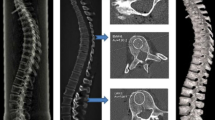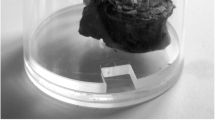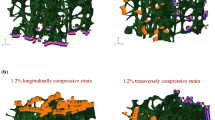Abstract
Summary
The aim of this study was to determine whether the Bone Strain Index (BSI), a recent DXA-based bone index, is related to bone mechanical behavior, microarchitecture and finally, to determine whether BSI improves the prediction of bone strength and the predictive role of BMD in clinical practice.
Purpose
Bone Strain Index (BSI) is a new DXA-based bone index that represents the finite element analysis of the bone deformation under load. The current study aimed to assess whether the BSI is associated with 3D microarchitecture and the mechanical behavior of human lumbar vertebrae.
Methods
Lumbar vertebrae (L3) were harvested fresh from 31 human donors. The anteroposterior BMC (g) and aBMD (g/cm2) of the vertebral body were measured using DXA, and then the BSI was automatically derived. The trabecular bone volume (Tb.BV/TV), trabecular thickness (Tb.Th), degree of anisotropy (DA), and structure model index (SMI) were measured using µCT with a 35-µm isotropic voxel size. Quasi-static uniaxial compressive testing was performed on L3 vertebral bodies under displacement control to assess failure load and stiffness.
Results
The BSI was significantly correlated with failure load and stiffness (r = -0.60 and -0.59; p < 0.0001), aBMD and BMC (r = -0.93 and -0.86; p < 0.0001); Tb.BV/TV and SMI (r = -0.58 and 0.51; p = 0.001 and 0.004 respectively). After adjustment for aBMD, the association between BSI and stiffness, BSI and SMI remained significant (r = -0.51; p = 0.004 and r = -0.39; p = 0.03 respectively, partial correlations) and the relation between BSI and failure load was close to significance (r = -0.35; p = 0.06).
Conclusion
The BSI was significantly correlated with the microarchitecture and mechanical behavior of L3 vertebrae, and these associations remained statistically significant regardless of aBMD.


Similar content being viewed by others
References
LeBoff MS, Greenspan SL, Insogna KL, Lewiecki EM, Saag KG, Singer AJ, Siris ES (2022) The clinician’s guide to prevention and treatment of osteoporosis. Osteoporos Int 33(10):2049–2102. https://doi.org/10.1007/s00198-021-05900-y
McDonnell P, McHugh PE, O’Mahoney D (2007) Vertebral osteoporosis and trabecular bone quality. Ann Biomed Eng 35(2):170–89. https://doi.org/10.1007/s10439-006-9239-9
Siris ES, Chen YT, Abbott TA, Barrett-Connor E, Miller PD, Wehren LE et al (2004) Bone mineral density thresholds for pharmacological intervention to prevent fractures. Arch Intern Med 164(10):1108–1112. https://doi.org/10.1001/archinte.164.10.1108
Kanis JA, Oden A, Johnell O, Johansson H, De Laet C, Brown J et al (2007) The use of clinical risk factors enhances the performance of BMD in the prediction of hip and osteoporotic fractures in men and women. Osteoporos Int 18(8):1033–1046. https://doi.org/10.1007/s00198-007-0343-y
Chapurlat R, Bui M, Sornay-Rendu E, Zebaze R, Delmas PD, Liew D, Lespessailles E, Seeman E (2020) Deterioration of Cortical and Trabecular Microstructure Identifies Women with Osteopenia or Normal Bone Mineral Density at Imminent and Long-Term Risk for Fragility Fracture: A Prospective Study. J Bone Miner Res 35(5):833–844. https://doi.org/10.1002/jbmr.3924
Chavassieux P, Chapurlat R (2022) Interest of Bone Histomorphometry in Bone Pathophysiology Investigation: Foundation, Present, and Future. Front Endocrinol (Lausanne) 13:907914. https://doi.org/10.3389/fendo.2022.907914
Boutroy S, Bouxsein ML, Munoz F, Delmas PD (2005) In vivo assessment of trabecular bone microarchitecture by high-resolution peripheral quantitative computed tomography. J Clin Endocrinol Metab 90(12):6508–15. https://doi.org/10.1210/jc.2005-1258
Vilayphiou N, Boutroy S, Szulc P, van Rietbergen B, Munoz F, Delmas PD, Chapurlat R (2011) Finite element analysis performed on radius and tibia HR-pQCT images and fragility fractures at all sites in men. J Bone Miner Res 26(5):965–73. https://doi.org/10.1002/jbmr.297
Gazzotti S, Aparisi Gómez MP, Schileo E, Taddei F, Sangiorgi L, Fusaro M, Miceli M, Guglielmi G, Bazzocchi A (2023) High-resolution peripheral quantitative computed tomography: research or clinical practice? Br J Radiol 96(1150):20221016. https://doi.org/10.1259/bjr.20221016
Messina C, Maffi G, Vitale JA, Ulivieri FM, Guglielmi G, Sconfienza LM (2018) Diagnostic imaging of osteoporosis and sarcopenia: a narrative review. Quant Imaging Med Surg 8(1):86–99. https://doi.org/10.21037/qims.2018.01.01
Roux JP, Wegrzyn J, Boutroy S, Bouxsein ML, Hans D, Chapurlat R (2013) The predictive value of trabecular bone score (TBS) on whole lumbar vertebrae mechanics: an ex vivo study. Osteoporos Int 24(9):2455–2460. https://doi.org/10.1007/s00198-013-2316-7
Ulivieri FM, Rinaudo L (2022) The bone strain index: An innovative dual x-ray absorptiometry bone strength index and its helpfulness in clinical medicine. J Clin Med 11(9):2284. https://doi.org/10.3390/jcm11092284
Morgan EF, Bayraktar HH, Keaveny TM (2003) Trabecular bone modulus-density relationships depend on anatomic site. J Biomech 36(7):897–904. https://doi.org/10.1016/s0021-9290(03)00071-x
Ulivieri FM, Rinaudo L (2021) Beyond bone mineral density: A new dual x-ray absorptiometry index of bone strength to predict fragility fractures, the bone strain index. Front Med 15(7):590139. https://doi.org/10.3389/fmed.2020.590139
Ulivieri FM, Rebagliati GAA, Piodi LP, Solimeno LP, Pasta G, Boccalandro E et al (2018) Usefulness of bone microarchitectural and geometric DXA-derived parameters in haemophilic patients. Haemophilia. 24(6):980–987. https://doi.org/10.1111/hae.13611
Rodari G, Scuvera G, Ulivieri FM, Profka E, Menni F, Saletti V et al (2018) Progressive bone impairment with age and pubertal development in neurofibromatosis type I. Arch Osteoporos 13(1):93. https://doi.org/10.1007/s11657-018-0507-8
Ulivieri FM, Rinaudo L, Piodi LP, Barbieri V, Marotta G, Scium’e M et al (2020) Usefulness of dual X-ray absorptiometry-derived bone geometry and structural indexes in mastocytosis. Calcif Tissue Int 107(6):551–558. https://doi.org/10.1007/s00223-020-00749-5
Ulivieri FM, Piodi LP, Rinaudo L, Scanagatta P, Cesana BM (2021) Bone strain index in the prediction of vertebral fragility refracture. Eur Radiol Exp 4(1):23. https://doi.org/10.1186/s41747-020-00151-8
Messina C, Rinaudo L, Cesana BM, Maresca D, Piodi LP, Sconfienza LM et al (2021) Prediction of osteoporotic fragility re-fracture with lumbar spine DXA-based derived bone strain index: a multicenter validation study. Osteoporos Int 32(1):85–91. https://doi.org/10.1007/s00198-020-05620-9
Ulivieri FM, Piodi LP, Rinaudo L, Scanagatta P, Cesana BM (2020) Bone strain index in the prediction of vertebral fragility refracture. Eur Radiol Exp 4(1):23. https://doi.org/10.1186/s41747-020-00151-8
Ulivieri FM, Rinaudo L, Piodi LP, Messina C, Sconfienza LM, Sardanelli F et al (2021) Bone strain index as a predictor of further vertebral fracture in osteoporotic women: an artificial intelligence-based analysis. PLoS One 16(2):e0245967. https://doi.org/10.1371/journal.pone.0245967
Sornay-Rendu E, Duboeuf F, Ulivieri FM, Rinaudo L, Chapurlat R (2022) The bone strain index predicts fragility fractures. The OFELY study Bone 157:116348. https://doi.org/10.1016/j.bone.2022.116348
Roux JP, Wegrzyn J, Arlot ME, Guyen O, Delmas PD, Chapurlat R, Bouxsein ML (2010) Contribution of trabecular and cortical components to biomechanical behavior of human vertebrae. An ex-vivo study. J Bone Miner Res 25:356–361. https://doi.org/10.1359/jbmr.090803
Roux JP, Wegrzyn J, Boutroy S, Bouxsein ML, Hans D, Chapurlat R (2013) The predictive value of trabecular bone score (TBS) on whole lumbar vertebrae mechanics: an ex vivo study. Osteoporos Int 24:2455–2460. https://doi.org/10.1007/s00198-013-2316-7
Martin RB, Sharkey NA (2001) Mechanical effects of post-mortem changes, preservation, and allograft bone treatments. In: Cowin SC (ed.) Bone Mechanics Handbook, 2nd ed., CRC Press, Boca Raton FL, USA, 20.1–20.24
Ashman RB, Donofrio M, Cowin SC, van Buskirk WC (1982) Postmortem changes in the elastic properties of trabecular bone. Trans Orthop Res Soc 7:63–67
Bouxsein ML, Boyd SK, Christiansen BA, Guldberg RE, Jepsen KJ, Müller R (2010) Guidelines for assessment of bone microstructure in rodents using micro-computed tomography. J Bone Miner Res 25(7):1468–86. https://doi.org/10.1002/jbmr.141
Hildebrand T, Rüegsegger P (1997) Quantification of bone microarchitecture with the structure model index. Comput Methods Biomech Biomed Engin 1(1):15–23. https://doi.org/10.1080/01495739708936692
Buccino F, Colombo C, Duarte DHL, Rinaudo L, Ulivieri FM, Vergani LM (2021) 2D and 3D numerical models to evaluate trabecular bone damage. Med Biol Eng Comput 59(10):2139–2152. https://doi.org/10.1007/s11517-021-02422-x
Colombo C, Libonati F, Rinaudo L, Bellazzi M, Ulivieri FM, Vergani L (2019) A new finite element based parameter to predict bone fracture. PLoS One. 14(12):e0225905. https://doi.org/10.1371/journal.pone.0225905
Wegrzyn J, Roux JP, Arlot ME, Boutroy S, Vilayphiou N, Guyen O, Delmas PD, Chapurlat R, Bouxsein M (2010) Role of trabecular microarchitecture and its heterogeneity parameters in the mechanical behavior of ex vivo human L3 vertebrae. J Bone Miner Res 25(11):2324–31. https://doi.org/10.1002/jbmr.164
Roux JP, Belghali S, Wegrzyn J, Rendu ES, Chapurlat R (2016) Vertebral body morphology is associated with incident lumbar vertebral fracture in postmenopausal women. The OFELY study. Osteoporos Int 27(8):2507–13. https://doi.org/10.1007/s00198-016-3558-y
Roux JP, Boutroy S, Bouxsein ML, Chapurlat R, Wegrzyn J (2020) Local and global microarchitecture is associated with different features of bone biomechanics. Bone Rep 13:100716. https://doi.org/10.1016/j.bonr.2020.100716
Maquer G, Lu Y, Dall’Ara E, Chevalier Y, Krause M, Yang L, Eastell R, Lippuner K, Zysset KP (2016) The initial slope of the variogram, foundation of the trabecular bone score, is not or is poorly associated with vertebral strength. J Bone Miner Res 31(2):341–6. https://doi.org/10.1002/jbmr.2610
Jackman TM, Hussein AI, Curtiss C, Fein PM, Camp A, De Barros L, Morgan EF (2016) Quantitative, 3D Visualization of the Initiation and Progression of Vertebral Fractures Under Compression and Anterior Flexion. J Bone Miner Res 31(4):777–88. https://doi.org/10.1002/jbmr.2749
Author information
Authors and Affiliations
Corresponding author
Ethics declarations
Conflict of interest
JP Roux, F. Duboeuf, E. Sornay-Rendu, J. Wegrzyn and R. Chapurlat declare they have no conflict of interest. Luca Rinaudo is Technical manager in Tecnologie Avanzate TA s.r.l. Bone Strain Index Project and Fabio Massimo Ulivieri is Scientific coordinator in Tecnologie Avanzate TA s.r.l. Bone Strain Index Project.
Disclosures
J.P. Roux: Research grant paid to the research institution UCB. R. Chapurlat: research grants UCB and Amgen, consulting UCB, Amgen, Mereo, Amolyt. F. Duboeuf, E. Sornay-Rendu, L. Rinaudo, F.M. Ulivieri and J. Wegrzyn declare they have no disclosure.
Additional information
Publisher's Note
Springer Nature remains neutral with regard to jurisdictional claims in published maps and institutional affiliations.
Rights and permissions
Springer Nature or its licensor (e.g. a society or other partner) holds exclusive rights to this article under a publishing agreement with the author(s) or other rightsholder(s); author self-archiving of the accepted manuscript version of this article is solely governed by the terms of such publishing agreement and applicable law.
About this article
Cite this article
Roux, JP., Duboeuf, F., Sornay-Rendu, E. et al. The relationship between bone strain index, bone mass, microarchitecture and mechanical behavior in human vertebrae: an ex vivo study. Osteoporos Int (2024). https://doi.org/10.1007/s00198-024-07066-9
Received:
Accepted:
Published:
DOI: https://doi.org/10.1007/s00198-024-07066-9




